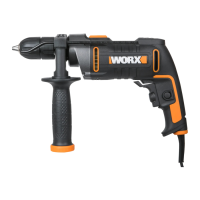Impact drill EN
1110
OPERATING INSTRUCTIONS
NOTE: Before using the tool, read the
instruction book carefully.
SECURE WORKPIECE
A workpiece clamped with clamping devices
is held more secure than by hand.
INTENDED USE
The machine is intended for impact drilling in
brick, concrete and stone as well as for drilling
in wood, metal and plastic.
ASSEMBLY AND OPERATION
ACTION FIGURE
Clamping and loosening the
Auxiliary Handle
WARNING! Always
check and rotate the
handle tightly before using to
avoid any accident.
See Fig. A1,
A2
Installing the Depth Gauge See Fig. B
Inserting Bits into Chuck See Fig. C1, C2
Plugging in the power See Fig. D
On/Off Switch and Lock-on
Button
See Fig. E
Variable Speed Control See Fig. F
Forward and Reverse
Rotation Control
NOTE: Never move
the forward/reverse
switch whilst the drill in
operation or the on/off
switch is locked as this
will damage the drill.
See Fig. G
Hammer or Drilling Control See Fig. H
WORKING HINTS FOR YOUR
DRILL
1. Drilling masonry and concrete
Select the drill/impact action selector switch
to the “hammer symbol” position. Tungsten
carbide drill bits should always be used for drilling
masonry, concrete etc with a high speed.
2. Drilling steel
Select the drill/impact action selector switch to the
“drill symbol” position. HSS drill bits should always
be used for drilling steel with a lower speed.
3. Pilot holes
When drilling a large hole in tough material (i.e.
steel), we recommend drilling a small pilot hole
first before using a large drill bit.
4. Drilling tiles
Select the drill/impact action selector switch to
the “drill symbol” position to drill the tile. When
tile has been penetrated, switch over to “hammer
symbol” position.
5. Cool the motor
If your power tool becomes too hot, set the speed
to maximum and run no load for 2-3 minutes to
cool the motor.
MAINTENANCE
Remove the plug from the socket before
carrying out any adjustment, servicing or
maintenance.
Your power tool requires no additional
lubrication or maintenance.
There are no user serviceable parts in your
power tool. Never use water or chemical
cleaners to clean your power tool. Wipe clean
with a dry cloth. Always store your power tool
in a dry place. Keep the motor ventilation slots
clean. Keep all working controls free of dust.
Occasionally you may see sparks through the
ventilation slots. This is normal and will not
damage your power tool.
If the supply cord is damaged, it must be replaced
by the manufacturer, its service agent or similarly
qualified persons in order to avoid a hazard.
If the replacement of the supply cord is necessary,
this has to be done by the manufacturer or his
agent in order to avoid a safety hazard.
TROUBLESHOOTING
1. If your power tool does not start, check the
plug on the power supply first.
2. If the drill doesn’t work properly, check the
drill bit for sharpness, replace drill bit if

